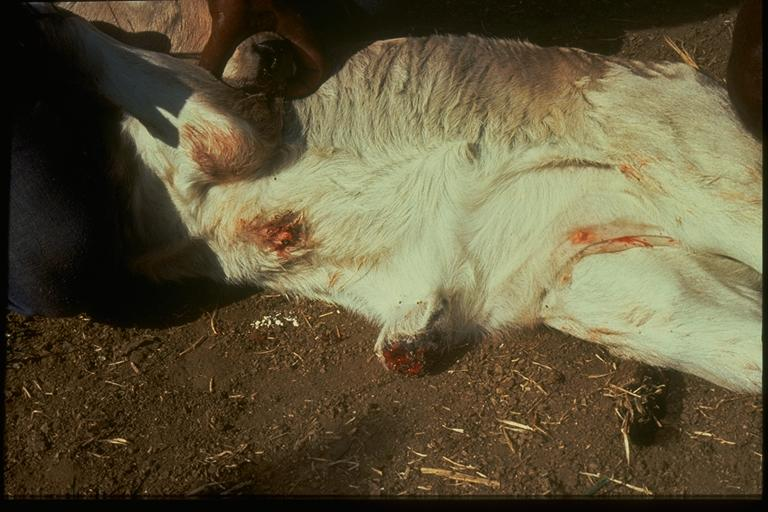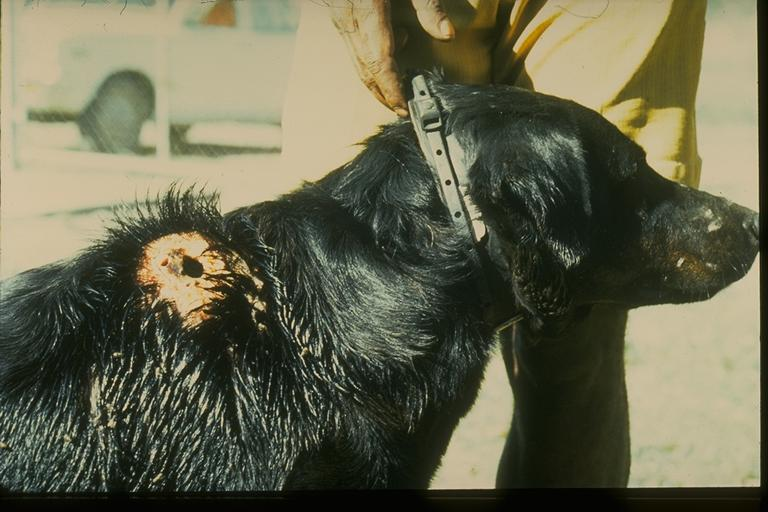| Market and human health implications of screw worm fly |
|---|
| If screw worm fly were to become established in northern Australia, husbandry practices would have to change and there would be additional operational costs involved in prophylactic treatment where husbandry practices resulted in wounds. Greater care and attention would also be needed for newborn animals.
Live export consignments would require additional treatments and examination to ensure freedom from screw worm fly for importing countries.
Screw worm fly can affect human health Screw worm fly is zoonotic, meaning it will infect people. If screw worm fly established in the tropics of Australia, this could pose a considerable health risk to people living in this area, particularly where there is limited access to sanitation. Screw worm fly may also have an impact on Australian wildlife.
This is why it is vital that animal owners in tropical or subtropical northern Australian contact their local veterinarian or DPIRD Field Veterinary Officer to report to report any wounds containing maggots on their animals in tropical or subtropical northern Australia. The earlier any infestation is found, the earlier it can be eradicated.
To report signs of screw worm fly During office hours, contact your nearest private veterinarian or DPIRD Veterinary Officer - see the Livestock Biosecurity contacts page. After hours, contact the Emergency Animal Disease hotline on 1800 675 888. |
What is screw worm fly?
Screw worm fly (SWF) are flies from the family of the blowflies (Calliphoridae).
There are two species of screw worm fly: Old World screw worm fly (Chrysomya bezziana) and New World screw worm fly (Cochliomyia hominivorax).
Screw worm fly lay their eggs (strike) on the wounds of living warm-blooded animals. The larvae (maggots) that emerge need the soft tissue of the wounds to develop, in particular wounds on livestock, domestic pets, wildlife and sometimes humans.
New World screw worm fly is found in tropical and subtropical areas of Central and South America as far as Argentina.
Old World screw worm fly occurs throughout much of tropical and subtropical Africa, some countries of the Middle East, India, south-east Asia and Papua New Guinea.
The fly looks like a blue blowfly and is related to the flystrike blowfly. For detailed images of screw worm fly, the damage it causes and its larvae, go to the Animal Health Australia website.


How could screw worm fly enter Australia?
Screw worm fly is an exotic pest that has not established in Australia. The risk of entry to Australia is considered extremely low but possible pathways for entry include from Papua New Guinea through illegal animal transport or on returning livestock vessels. The Australian federal Department of Agriculture and Water Resources has pre-border surveillance programs for both of these pathways. A third pathway is via people who have visited or come from countries where screw worm fly occurs.
Animals most at risk
Any wound or skin break is a potential area for screw worm fly to strike and for their maggots to develop.
Wounds may occur naturally such as the navels of newborn animals or as a result of husbandry practices like dehorning, ear tagging, ear marking and castrations. Skin penetrations ranging from fighting and transport injuries to tick bites will allow screw worm fly to lay their eggs.
How is screw worm fly spread?
The screw worm fly survives in tropical and subtropical areas where there is access to warm-blooded animals and an environment that provides moisture, vegetation and shade. Wounding is the usual requirement for screw worm fly to strike. The screw worm fly needs wounds to survive and without this there is no ability to lay their eggs and for the new cycle of maggots to develop. Where livestock are not present, wildlife can become an important source of wounds for screw worm fly.
Once the screw worm fly has laid eggs on a wound or skin penetration, maggots hatch within 12-20 hours and enter the wounds, burrowing into the underlying tissues to feed on blood. This causes a lot of tissue damage and destruction.
Maggots develop quickly and within in 6-7 days drop out of the wounds on to the ground and burrow into the soil, where they pupate and emerge as adult flies within a week in good conditions.
Signs of screw worm fly infestation
Signs of infestation of maggots in animals include:
- visible maggots in wounds
- constant licking of the wound
- restlessness
- fever
- lethargy
- infected, smelly and bleeding wounds, sometimes with pus and maggots emerging
- hard and swollen navels.
Common areas for SWF to strike include the:
- head and surrounding area
- brisket
- genital area
- navel.
Surveillance to help diagnose screw worm fly presence early
DPIRD, in conjunction with the federal Department of Agriculture and Water Resources Northern Australian Quarantine Strategy (NAQS), conduct ongoing screw worm fly surveillance in northern Australia, including lure-based fly trapping, especially in the Torres Strait islands, monitoring of sentinel cattle herds in northern Australia and ongoing testing of maggots submitted by animal owners in northern Australia.
Any animal owner in tropical or subtropical northern Australia who notices wounds containing maggots on their animals should contact their local veterinarian or DPIRD Field Veterinary Officer for further advice.
How a vet can help
Any wound that contains maggots should be treated after the collection of maggots for examination and a veterinarian can offer the best advice on how this should be done.
Maggots can be collected from the wound and stored in the fridge or in ethanol if available. Immediately contact the local veterinarian or DPIRD Veterinary Officer for advice so that these animals and samples of the maggots can be examined to rule out screw worm fly infestation.
Diseases that look like screw worm fly
Flystrikes from other blowflies common to Australia may look like screw worm fly infestations. These include:
- hairy maggot blowfly (Chrysomya rufifacies)
- steel-blue blowfly (Chrysomya saffranea)
- the sheep flystrike blowfly (Lucilia cuprina).
Reporting signs similar to screw worm fly
It is important to report and submit samples of any maggots found in wounds to the local DPIRD Veterinary Officer or private veterinarian. Any flystrike of cattle in northern Australia should be investigated to rule out screw worm fly.
- During office hours, contact your nearest private veterinarian or DPIRD Veterinary Officer - see the Livestock Biosecurity contacts page.
- After hours, contact the Emergency Animal Disease hotline on 1800 675 888.
More information
For more information about screw worm fly, visit the Animal Health Australia website or the federal Department of Agriculture website.
